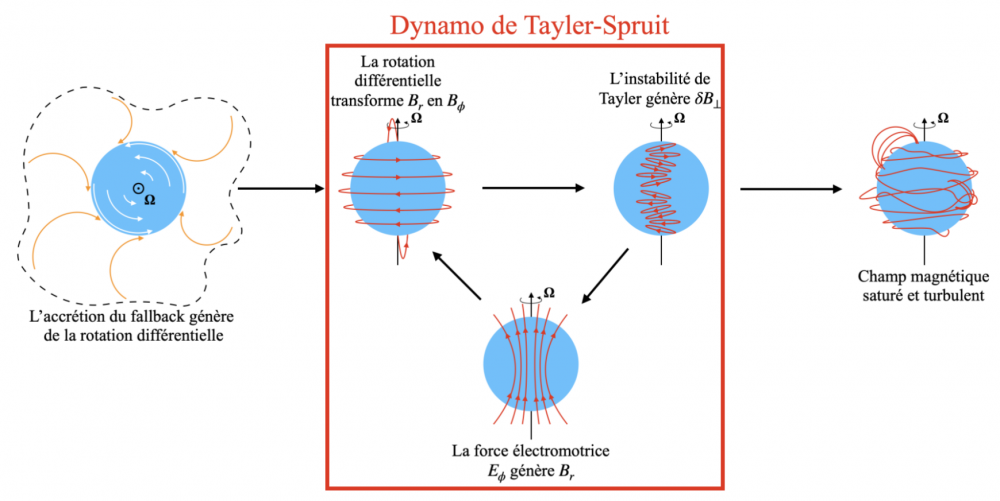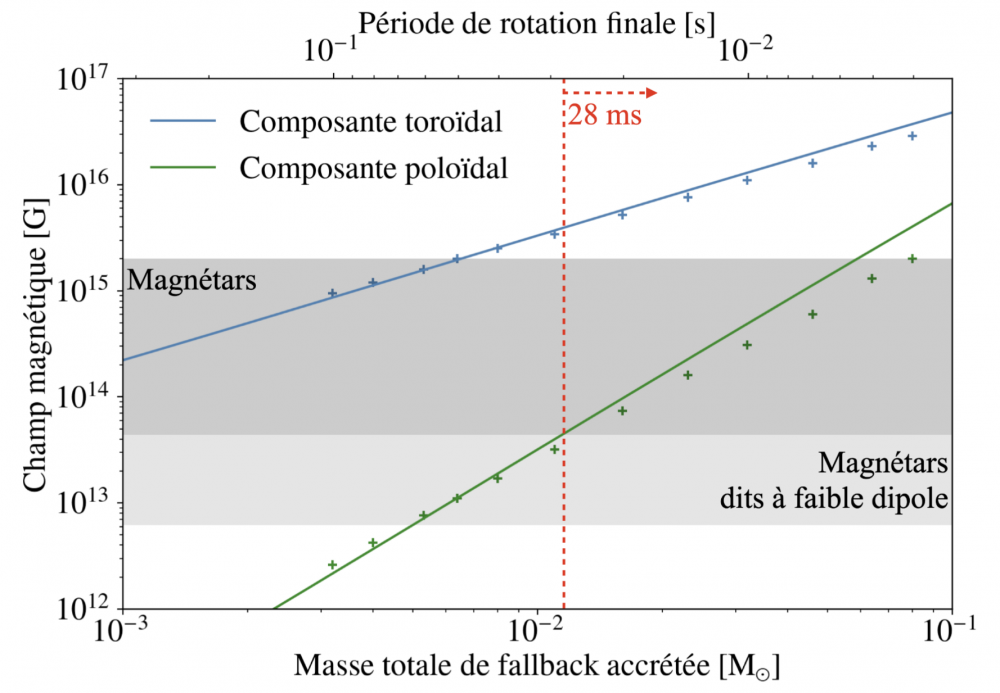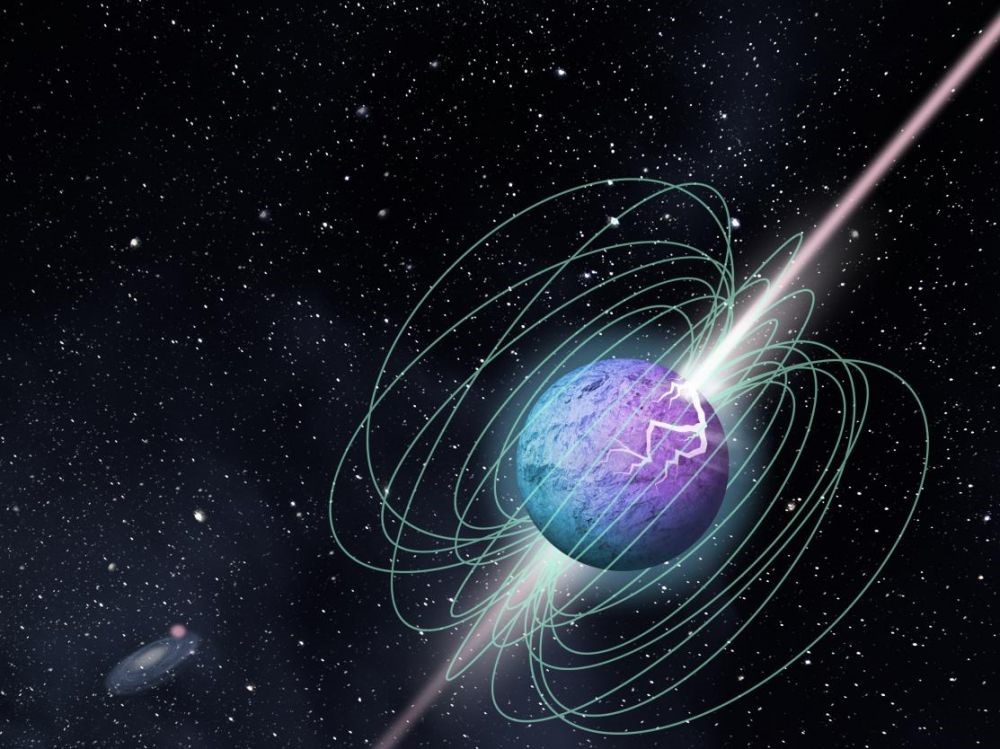Magnetars are neutron stars known for their wide variety of electromagnetic emissions coming from the dissipation of their extreme magnetic fields, which are the strongest known in the Universe and can reach 1015 Gauss, or 10 billion times that of the strongest magnet created by humans.
How could these magnetic fields have been formed? This is one of the open questions that a Franco-German team led by the supernovae team of the Department of Astrophysics (DAp) of CEA Paris-Saclay, has recently tried to answer by proposing a numerical modeling of a new scenario of formation of magnetars in a study published in the scientific journal "Astronomy and Astrophysics".
This scenario suggests that the matter falling on the neutron star a few seconds after its formation can trigger a dynamo effect called Tayler-Spruit which would amplify its magnetic field, and this independently of its initial rotation speed. The simulations of this scenario reproduces the measured intensity of magnetar magnetic fields. Therefore, this study represents another step towards the understanding these atypical objects.
What are magnetars?
Stars are all born in the same way, within a molecular cloud, but do not end their lives in the same way. This depends on their mass. During their existence, the core of a star fuses increasingly heavier elements, producing enough energy to counterbalance the weight of the outer layers that continuously compress the star.
When a medium-mass star like the Sun runs out of hydrogen, its core compresses in an attempt to fuse heavier chemical elements. This step generates a lot of energy that blows the outer layers of the star. These layers expand into space, creating a planetary nebula, while the core becomes a white dwarf, gradually cooling and fading away. The death of a more massive star, at least eight times the mass of the Sun, is more cataclysmic. When its iron core, produced by the fusion of lighter elements, reaches a critical mass, it collapses upon itself abruptly. The compression is so strong that protons and electrons combine to form neutrons. This contraction generates a shock wave that expels the outer layers of the star in an explosion known as a supernova. The resulting object is an extremely dense neutron star. Within a radius of about ten kilometers, its mass is equivalent to that of the Sun!
Among the different manifestations of neutron stars, magnetars are distinguished by transient X-ray and gamma-ray emissions. These intense radiation bursts draw their energy from the dissipation of abnormally high magnetic fields. The measurement of the slowing down of their rotation period - induced by a magnetic braking effect - confirms this scenario. It is thus estimated that magnetars have a dipolar magnetic field of the order of 1015 Gauss (G), up to 1000 times stronger than the typical magnetic field of neutron stars. If the existence of these extreme magnetic fields is well established, their origin remains controversial.

Figure 2: Schematic representation of the three main steps of the scenario of magnetic field amplification by the Tayler-Spruit dynamo in a fallback accelerated proto-neutron star: 1. accretion of the fallback (stellar matter falling back on the star); 2. Development of the Tayler-Spruit dynamo; 3. Saturation of the magnetic field. The blue spheres represent the proto-neutron star. The dotted line represents the fallback zone whose orange arrows represent the motion. The red and white lines illustrate respectively the magnetic field lines and the fluid motions.
Why study a new formation scenario?
Several scenarios attempt to explain how the magnetic field can amplify during the death of massive stars to give rise to the particularly high magnetic fields of neutron stars.
On one hand, some theories propose that the magnetic field of magnetars is entirely determined by that of the iron core of the progenitor star. The magnetic field would be amplified through the conservation of the magnetic flux during the core collapse, whose initial magnetization remains however uncertain.
On the other hand, some scenarios lean towards an amplification during the very first seconds of the neutron star's life. Two promising dynamo mechanisms have been studied through numerical simulations by the supernovae team of the Astrophysics Department, CEA Paris-Saclay. The first mechanism involves convective motions inside the protoneutron star, while the second invokes an instability of a differentially rotating fluid in the presence of a magnetic field. However, both theories assume a rapid rotation of the iron core of the progenitor star. However, Recent asteroseismic observations have shown that the core of a dying star tends to rotate more slowly than predicted by the stellar evolution models.
These new results suggest that a sufficiently fast rotation is likely too rare to explain the formation of all magnetars, and justify the search for new scenarios.
Result of the new study
In this new scenario, researchers from the supernovae team at Dap and the Max Planck Institute suggest that the amplification of the magnetic field in magnetars is due to the matter ejected during the star’s explosion. Some of this material remains gravitationally bound to the proto-neutron star, and eventually falls back onto its surface. This phenomenon is known as "fallback".
Since the accretion of this matter is asymmetric, it accelerates the rotation of the surface of the proto-neutron star, making it faster than the rotation of the internal layers. According to these researchers, this differential rotation promotes the development of a dynamo which had never been studied in the context of neutron stars: the Tayler-Spruit dynamo (see Figure 2).
To verify if this formation scenario is relevant for magnetars, the authors of this study developed a numerical model of this physical process by evolving a weak magnetic field over time, and for different speeds rotation of a newly formed proto-neutron star.And the results are consistent: the researchers find the expected intensity and structure of the magnetic field in magnetars, even with slow rotation, unlike previous scenarios that required rotation three times faster. This new scenario is promising and complements the two others to explain the formation of the majority of magnetars, born in standard supernovae.
The research team is currently working on studying the Tayler-Spruit dynamo via 3D numerical simulations. These simulations are necessary to obtain precise description of the dynamo mechanism in three dimensions and thus to verify the validity of the proposed model.

Figure 3: Magnetic field intensity at the end of the Tayler-Spruit dynamo amplification as a function of the final rotation period of the proto-neutron star, which is related to the accreted fallback mass. The blue and green colors represent, respectively, the toroidal and poloidal components of the magnetic field. The crosses indicate the magnetic field intensities obtained by solving the equations of our model for fixed rotation periods. The solid lines are an approximation of the relationship between the magnetic field and the rotation period derived from the analytical model. The grey areas represent the range of magnetic dipole intensities inferred from magnetar observations (dark grey) and low dipole magnetars (light gray). The predicted intensity for the poloidal field (green curve), which is assumed to be of the same order as the dipole, is in the range of the magnetars for a rotation period greater than 28 ms.
Contacts: Paul Barrère, Jérôme Guilet, Raphaël Raynaud
• Structure and evolution of the Universe › Planets, star's formation and dynamics, interstellar medium
• Department of Astrophysics (DAp) // UMR AIM
• Astrophysical Plasma Modelling Laboratory • High Energy Cosmic Phenomena Research Laboratory




